| ..... |

Smithsonian Folkways Series
Volume 1 to Volume 10
Covers, RealAudio sound files,
and purchase links via amazon.com
|
| |
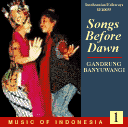
Volume 1
East Java 1:
Songs Before Dawn--
Gandrung Banyuwangi
Purchase
info
and RealAudio samples |
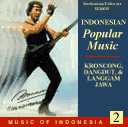
Volume 2
Indonesian Popular
Music: Kroncong, Dangdut,
and Langgam Jawa
Purchase
info
and RealAudio samples |
| |
Volume 1
The vibrant and earthy musical genre called gandrung accompanies
a dance at the end of an all-night celebration, when the accumulated sexual
tension of male partygoers needs to be safely dissipated. The provocatively
dressed female gandrung dancer/singer emerges (backed by a small ensemble
of musicians who play violins, drums, and metal percussion) accompanied
by a clownish male vocalist, the pengudang.
As she flirts and flits her way through the audience, flicking her scarf
at her dance partner/victim of the moment, the penduang goads her with a
steady stream of ribald remarks, commands and encouragements. The suite
is recorded here is a full performance by one of the music's finest living
singers, Gadrung Temu.
Volume 2
Though the polished pop called dangdut (named for its
tabla two-beat "dang-doot" anchor) at first blush seems safe and
conservative, innovator Rhoma Irama made a big noise by using his music
to protest the lot of his country's poor and by advocating a return to Koranic
values. Though western rock provides the imagery, basic instrumentation
and production values, dangdut leans more heavily on filmi, Indian film
music.
Rounding out the disc are examples of kroncong, nostalgic pop
with roots in the 19th century as the music of Eurasian toughs. Its current
incarnation, solidified in the 1930s, holds little indication of a life
spent on the streets. But it does clearly reflect a Portuguese origin in
cascades of arpeggiated guitar and gliding vocals that call to mind American
cowpoke and Hawaiian ditties. |
| |
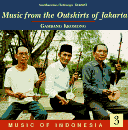
Volume 3
Music from the
Outskirts of Jakarta:
Gambang Kromong
Purchase
info
and RealAudio samples |
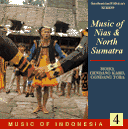
Volume 4
Music of Nias and
North Sumatra: Hoho,
Gendang Karo,
Gondang Toba
Purchase
info
and RealAudio samples |
| |
Volume 3
The old repertoire lagu lama comprising the first half
of the disc isn't exactly your average roadside pop attraction. A lovely
twisting current of fiddles, metallophones, flute and voice parry in and
out, above and below, and on both sides of a melody, revealing a song's
essence by cagily defining the negative space around it. Modern repertoire
lagu sayur takes the shape of a shocking collision between New Orleans
jazz and gamelan styles. Mexicali trumpet, Hawaiian guitar, gamelan backbeat,
Chinese violin and Keith Moon percussive wallops shoot off blithely in their
own directions, unconcerned as a Lisbon-via-Macao vocalist conducts a dogmatic
discourse over the fray. After a few listenings the apparent traffic jam
resolves itself into a joyous street parade.
Volume 4
Gendang lima sedalanen consists of plague-of-locusts soloing
on the sarune--a kind of high-pitched oboe--atop popcorn percussion
bursts from a trio of the planet's smallest drums. Think of a furiously
buzzing Egyptian mizamar set against a hail storm in a scrap yard,
or how your head feels after a hangover. Add a moon-eyed female vocalist
to the second cut, and you're close to the effect of this bright and brittle
music.
Soothing in comparison are the sonorous a capella hoho choral songs
from the thickly forested island of Nias. Built on a measly four-tone scale,
hoho sounds far richer due to the dramatic modulation of notes by
the male leader and back-up singers as they perform overlapping phrases,
the sharp precision of the pieces accented by the megalithic courtyard where
the music was recorded. Hoho sounds like tones extracted from stones, a
tapping into essential harmonies similar in sacred resonance to the chants
of Tibetan monks.
In gondong sabangunan of North Sumatra's Toba people, tuned drums
playing full melodies lay the groundwork for literally breathless flights
on the sarune. A circular breathing technique allows the sarune performer
to blow nonstop for long durations without having to come up for air, no
doubt encouraging the trance-like intensity of these seemingly boundless
solos. |
| |
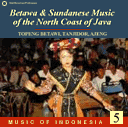
Volume 5
Betawi & Sundanese
Music of the North
Coast of Java
Purchase
info
and RealAudio samples
|
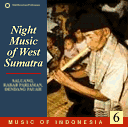
Volume 6
Night Music of
West Sumatra: Saluang,
Rabab Pariaman,
Dendang Pauah
Purchase
info
and RealAudio samples |
| |
Volume 5
The three styles presented on the disc, especially examples of
tanjidor and ajeng, come across like an art school student's
wetdream of fourth world jazz. Tanji Modern Grup Marga Luyu jolt unfamiliar
meandering tones and unsettling harmonies from familiar European brass band
instruments, from the fractured waltz through the rubble of a Bavarian beer
garden on "Was Pepko" to the mewling saxophonics raising hackles
against an exhausted New Orleans funeral parade on "Gaple." Yet
even this assault on the vaguely recognizable is pathetic preparation for
the sheer unwavering intensity of the three ajeng tracks, which feature
a local Pharaoh Sanders blowing endless circular breaths through a complaining
shawm. Around him, members of a gamelan ensemble speed up or throw on the
brakes as inspiration seems to strike them in the rare metallophone-driven
pieces on all of Java that toss cyclic structure to the trade winds.
Volume 6
These highly intimate chamber music performed with only one or
two singers and a single accompanying flute or bowed lute were a little
too subtle in theory and practice for me. According to the label, these
1990-1992 recordings from the coastal region near Jakarta focus on one of
the richest traditions of the performing arts found in Indonesia. They're
certainly pleasant enough as background music, though that's kind of the
same as damning them. |
| |
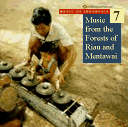
Volume 7
Music from the
Forests of Riau &
Mentawai
Purchase
info
and RealAudio samples |
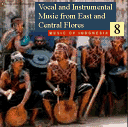
Volume 8
Vocal & Instrumental
Music from East &
Central Flores
Purchase
info
and RealAudio samples |
| |
Volume 7
Recorded in 1993 and 1994, this recording focuses on the music
of three indigenous forest societies of western Indonesia. It features songs
and drumming for shamanic curing rituals, and private singing and instrumental
music (played on xylophones or a gong-row) performed for entertainment or
emotional release.
Volume 8
Flores serves up lots of manly singing--in particular, men's
choruses from the Sikku Regency performing a cross between Polynesian vocal
music and raucous English football songs. Melodies of these first group
of pieces are simple, but the dynamics bring them alive, as a lead vocalist
backed by sparse percussion is unexpectedly joined by an entire throng ringing
out a rounded-vowel chorus that put me in mind to sign up with a truck driving
school. Deedle-deedle vocal counterpoints ornament the Lero Men's chorus
on the second cut, while the Sora Men's chorus favors throbbing handdrums.
Elsewhere on the disc are male and female vocal duets disturbingly similar
to Bulgarian village styles right down to the verse-concluding "whee!"
on "Lalu Gogok." |
| |
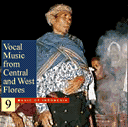
Volume 9
Vocal & Instrumental
Music from Central &
West Flores
Purchase
info
and RealAudio samples |
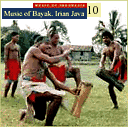
Volume 10
Music of Biak,
Irian Jaya: Wor,
Church Songs, Yospan
Purchase
info
and RealAudio samples |
| |
Volume 9
Series editor Philip Yampolsky found more diversity on Flores
than he had imagined, calling the island "a textbook anthology of vocal
music" and devoting two discs to the performances. Volume 9 is an admirable
follow-up if you enjoy the styles on Volume 8, but I found the relentless
dissonance somewhat off-putting. These 1993 and 1994 recordings present
the virtually unknown choral singing of Ngada and Manggarai. The songs,
performed mainly at funerals and agricultural rituals, include rare instances
of Indonesian counterpoint.
Volume 10
This album presents music for celebrations and church services
on Biak Island in Irian Jaya, which is the Indonesian name for the western
portion of the island of New Guinea. Wor songs, usually sung by choruses
in seemingly chaotic, free-for-all style, were once central to traditional
Biak society. Two other genres have recently developed: church songs , sung
here by women's choirs in churches and in secular performances; and yospan,
string based music for dance parties. |
| |
Music of Indonesia, Introduction
Music of Indonesia, Volumes 1-10
Music of Indonesia, Volumes 11-20
Technobeat Central
|